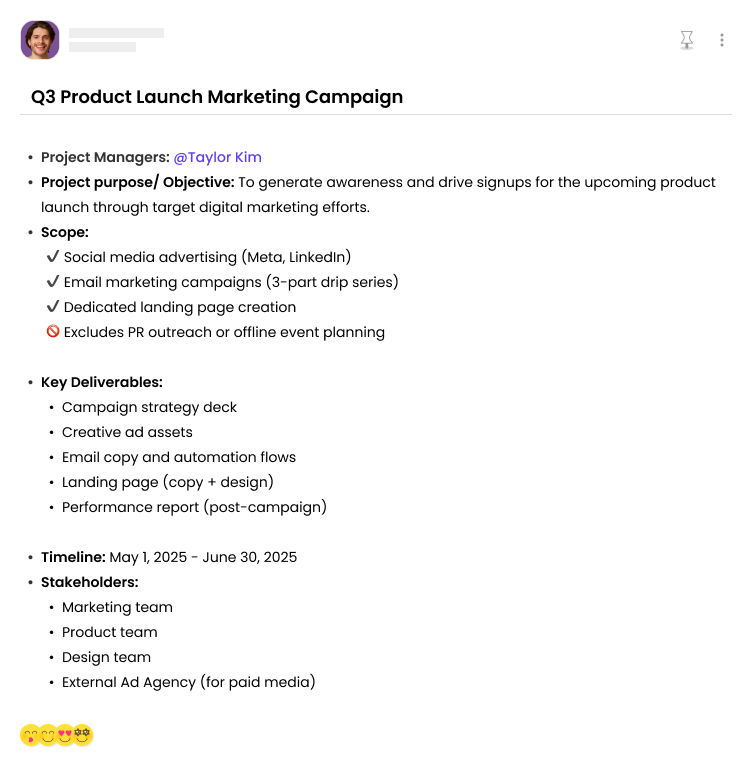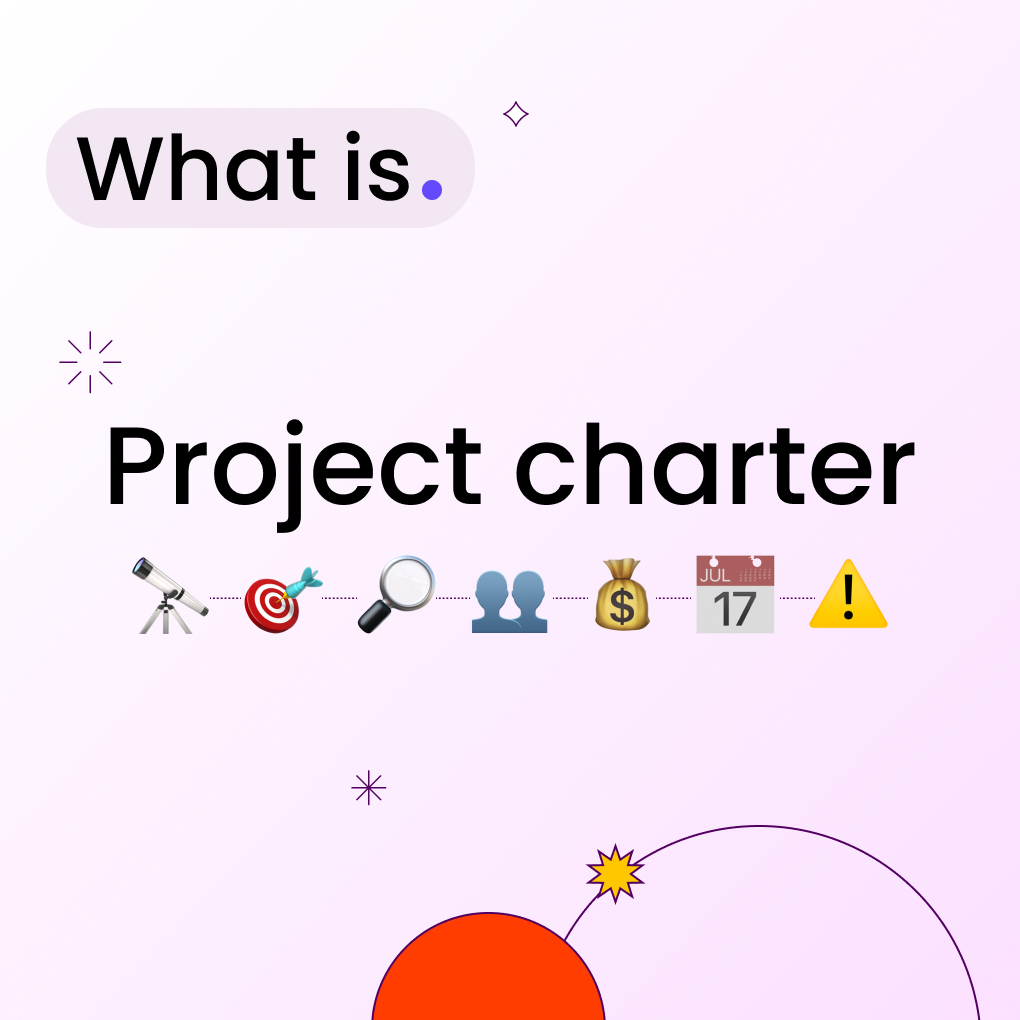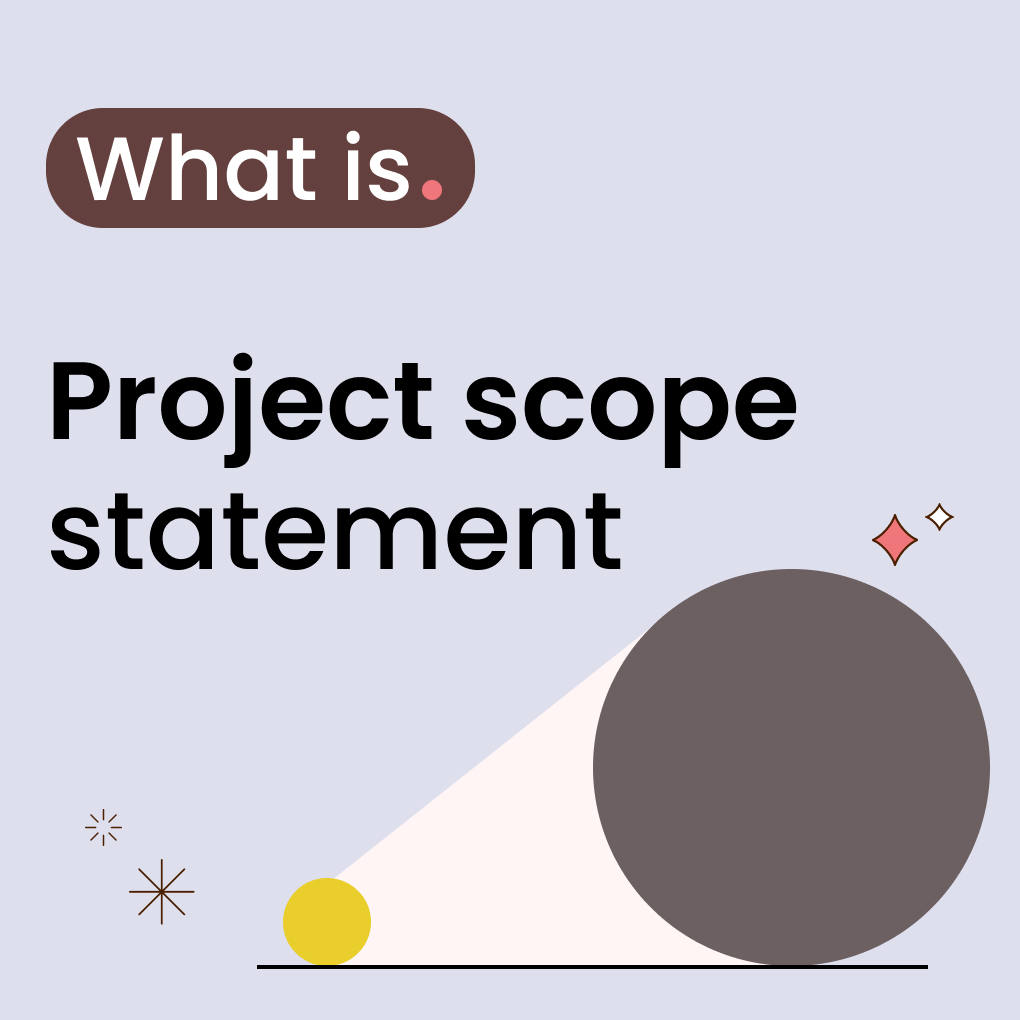What is a project charter, and why does your project need one? A project charter is the foundation of your project, which helps define the project’s purpose, scope, and stakeholders. Without it, teams risk confusion, misalignment, and wasted effort. This essential document answers critical questions: Why does this project matter? What will it deliver? Who’s involved? And how will success be measured?
A well-designed charter can take an idea and make it happen for a small task or a larger initiative. “Whether managing a small task or a large initiative, setting up a charter transforms ideas to action”! The main difference between a messy project and one that succeeds is simply the charter.
What Is a Project Charter?
A Project Charter is simply the first step in any successful project. It is a memorandum that formally allows the project to exist and provides a clear direction. Before the work begins, all stakeholders understand the project’s goals, limits, and expectations. Teams face misalignment, scope creep, and wasted resources without a charter.
Project Charter Definition.
A project charter is an official document that kicks off the project. It creates goals, scope, and critical stakeholders. The Project Management Institute (PMI) states that a project manager can utilize organization resources. The charter answers essential questions about why the project matters, what it will deliver, and who will be involved.
A project charter is a document that keeps everyone involved in the project in sync. Unlike the project plan, it doesn’t include specifics at the task level. Instead, it looks at the big picture: what you will achieve and why.
What Does a Project Charter Include?
A strong project charter should contain the necessary elements of a project but not in excess. It usually describes the project’s objectives, scope, and success criteria. It also says people involved, budget, and risks in that order. Some charters outline a timeline of significant milestones. However, the exact deadlines are usually specified later in the project plan.
Those searching for examples of project charters will notice standard sections like project background, deliverables, and constraints. For example, a business charter could focus more on financial reasons, whereas a technical project charter could focus more on system requirements. All projects, whether technical or informative, have the same structure: goals, limits, and responsibilities.
Project Charter vs. Project Plan
A project charter and project plan are often confused. They are vastly different. The charter comes first and authorizes the project. It answers the “what” and “why” at a high level. On the other hand, the project plan illustrates “how” the work will be done. Teams provide project plans to management for approval.
A common question is, “Does the project charter create project scope?” The answer is yes—it establishes the initial scope, but the project plan refines it further. A charter defines the limits, and the plan breaks them down into tasks and times. By skipping the charter and directly planning, confusions crop up as teams may not have a clear start understanding.
Project Charter vs. Business Case
People get confused regularly over a project charter and a business case. A business case makes a case for creating the project, including costs, benefits, and ROI. It’s used to secure approval and funding. Once approved, the project charter defines how the project will be executed.
Those looking for a how to write business charter template sample might find hybrid documents that combine both elements. However, keeping them separate is often better. A business case persuades decision-makers and keeps projects on track with a charter. A charter example for launching a new product would prioritize market opportunities, while a project charter would prioritize milestones and critical roles.
What Is the Purpose of a Project Charter?
A Project Charter Is a document that starts a project and keeps the project team focused and on track. If the team lacks a clear charter, it will often wind up busy with unclear goals, changing requirements and many efforts on only a few. A project charter describes what the project will try to achieve and how. It acts as a formal reference point.
Why a Project Charter Is Important
It’s essential to have a project charter because it creates clarity. All stakeholders get to know the reason behind starting the project and their expectations. When you learn the project charter writing, please keep it simple but thorough so that it does not confuse anyone later.
The charter also helps secure approval and resources. Setting objectives and success criteria early on assures decision-makers of the right path for the project.
When to Create a Project Charter
The best time to draft a project charter is before central planning begins. Once a project idea is approved, it should be one of the first steps. Some teams skip the charter and go straight to execution. This is a big mistake that gets them into trouble.
When you work on a program charter (which involves multiple related projects), the charter phase defines how all the pieces fit together. Similarly, a project budget in the project charter should be estimated early, even if exact numbers come later. The charter sets the financial boundaries and ensures realistic expectations.
Does the Project Charter Create Project Scope?
The project charter sets the preliminary scope but is not very detailed. It sets limits on what the project would include and what it would not include. Doing so helps prevent scope creep, which is a common misdoing that happens very often.
When you learn how to write a charter, defining the project scope is one of the most critical steps. The charter should explain high-level deliverables, such as “build a new website” or “launch a marketing campaign.” The specific tasks will come later in the project plan, but the charter ensures everyone is on the same page regarding the overall direction first.
Components of a Project Charter
A project charter organizes a project by defining the key elements in one document. These parts will help give teams direction and keep stakeholders aligned. While formats may vary across organizations, most effective charters contain several core sections that address fundamental project needs. Understanding these essential pieces helps when creating or reviewing project charter examples.
1. Project Overview and Background
Every strong project charter begins with a clear overview. This part talks about the project and its importance for business. It usually includes a project name, a brief description, and the underlying business need for the project. The background information allows the team and stakeholders to understand. Many project charter examples begin with this section, as the charter acts as the reference document for the project, which offers justification.
2. Objectives and Success Criteria
The objectives define what the project aims to accomplish. Clear and measurable objectives make it easy to know when the project is successful. This section should also include success criteria – the concrete standards used to evaluate results. In many project charter examples, objectives connect directly to business goals, showing how the project contributes to more significant organizational priorities. Clear success criteria prevent disputes later about whether deliverables meet expectations.
3. Scope and Deliverables
The scope outlines what work the project will and won’t include. The question is does project charter create scope of project? It defines boundaries to prevent uncontrolled expansion of work. Deliverables refer to the things the project will produce. Much focus is put on the scope and deliverables sections of the project charter elements because they impact timelines and resourcing.
4. Project Team and Stakeholders
This part defines who is involved and who is impacted by the project. It lists essential project members, their duties, and primary stakeholders. Including this information in a project charter as early as possible is vital to ensure understanding. Numerous examples of project charters include organizational charts or matrices of responsibility illustrating reporting relationships and authority.
5. Budget and Resource Needs
The budget section provides high-level estimates of financial requirements and key resources needed. While detailed cost breakdowns come later, the charter establishes spending expectations and resource commitments. This helps secure necessary approvals and prevents resource shortages during execution. Project charter components related to budget often include financial and non-financial resources like equipment or specialized skills.
6. Timeline and Milestones
Every project needs a scheduling framework. The charter includes major phases and key milestone dates rather than detailed task schedules. These time markers help track progress and maintain momentum. There may be different timelines in various project charter examples, but all successful ones show some schedule expectation for aiding in planning and execution.
7. Risks, Constraints, and Assumptions
This final central section identifies potential challenges and limitations. Risks are possible problems that occur. Constraints are fixed limits like budget caps or deadlines. Assumptions are factors believed to be true but not confirmed. Documenting these project charter elements helps us prepare for the challenges and clarifies the conditions of this project. Many project issues can be attributed to unstated assumptions and unrecognized constraints. Therefore, this section is a valuable one.
How to Write a Project Charter (Step-by-Step)
Making a project charter may seem complex. However, creating in some steps will help you create it easily. A charter helps the team understand what will be done and why the project is being executed. A structured approach keeps everything clear and informative, yet it helps produce an explicit and valuable document.
Step 1: Define Project Purpose and Background
Start by explaining why the project exists. The project provides a solution to a problem or an opportunity; it is important to share its importance. Give background information to explain something relevant to stakeholders. For example, if it’s about launching a new product, mention market or customer demand that supports the project. As seen in many project charter examples, this section is often a short paragraph stating the project’s justification.
Step 2: List Goals and Objectives
Next, define what the project aims to achieve. Goals must not be too broad; otherwise, they will be ineffective. Instead of vague goals like “enhance customer service,” strive for specific ones. You might set out to decrease the customer response time from 24 to 12 hours. The project charter meaning gets clearer when objectives are directly linked with business needs. This helps teammates realize how their efforts contribute to larger organizational goals.
Step 3: Outline the Project Scope
Clearly state what work the project will include and, just as importantly, what it won’t. The scope section sets boundaries to prevent uncontrolled expansion of work. For instance, a website redesign project might include new page layouts but exclude content creation. Reviewing project charter examples can help identify common ways to phrase scope statements. A well-defined scope helps teams stay focused, and managers allocate resources appropriately.
Step 4: Identify Stakeholders and Team
List all key people involved in or affected by the project. Include team members with their roles, decision-makers, and any external partners. The project charter in project management often serves as the first place where responsibilities get formally assigned. Clearly showing who does what prevents confusion later. For larger projects, some charters include simple organizational charts or responsibility matrices in this section.
Step 5: Estimate Budget and Resources
Provide high-level estimates of costs and resources needed. While exact numbers may come later during planning, the charter should establish reasonable expectations. Include both financial requirements and other resources like equipment or specialized skills. The project charter format typically keeps this section brief but specific enough to support initial approvals. Mention whether the budget has flexibility or represents a firm limit.
Step 6: Set Project Timeline and Deadlines
Schedule the significant dates and milestones without a detailed plan. The major phases and important deadlines help everyone understand the project’s tempo. For example, a software development project might set milestones for completing designs, tests, and launches. A timeline in a project charter provides a framework for more detailed planning that comes later. It also helps stakeholders harmonize their expectations about when results will be delivered.
Step 7: Add Success Criteria, Risks, and Assumptions
End by clarifying how success and failure will be measured and the conditions on which this project depends. It is good and effective when success criteria are measurable.” Risks might include potential delays or resource shortages. Assumptions could be factors like “vendor will deliver materials on time.” These elements complete the project charter by addressing uncertainties and setting clear standards for evaluation.
Project Charter Examples & Templates
Real-life examples will help you understand how to prepare a project charter. Most project charters share a few common elements and approaches. Looking at samples can inspire you and ensure you have everything you need. Whether looking for a business-focused example or a technical project template, these references make the charter-writing process easier.
Marketing Project Charter

A marketing campaign project charter includes the title, objectives, key deliverables, and other details. The scope might cover social media ads and email marketing but exclude PR activities. Such examples of project charters show how to keep the document practical and action-oriented. They demonstrate how to define project charter elements clearly without unnecessary complexity.
Business Charter
A business charter often emphasizes financial outcomes and strategic alignment. For example, a charter for opening a new retail location would outline revenue goals, market analysis, and operating requirements. Business charters usually have more detail about ROI and stakeholder expectations than technical ones. Whether you’re looking for a business charter template sample for healthcare or manufacturing, such a template is available.
Program Charter vs. Project Charter
Understanding the difference between these two documents is essential. A project charter covers a single initiative with defined start and end dates. A program charter coordinates multiple related projects under one umbrella. For example, a digital transformation program charter might include separate projects for CRM implementation, staff training, and process redesign. While similar in structure, program charters have a broader scope and more focus on interdependencies between projects.
Project Charter Best Practices
A well-crafted project charter sets the stage for success, but not every team gets it right. Using tried-and-true methods helps us develop a document that guides the project and doesn’t get wrong. These best practices arise when working on a small internal initiative or a sizeable cross-functional project.
How Detailed Should a Project Charter Be?
The ideal project charter balances completeness with clarity. It should include all key project charter components but remain concise enough to be useful. A good rule is to keep it between one to three pages for most projects. The charter should define the project at a high level without diving into task details. For example, the project budget in the project charter should show overall estimates rather than line-item costs.
Common Mistakes to Avoid
Many teams make similar errors when creating their project charter. One frequent mistake is writing vague objectives that can’t be measured. Another is failing to identify all stakeholders, leading to later communication gaps correctly. The project charter elements must be clear and specific to prevent these issues. Even minor oversights in the charter can create big problems during execution.
Aligning Your Charter with Project Goals
Every part of the project charter should connect directly to the project’s purpose. The objectives, scope, and success criteria must all support the same results. When writing a charter, constantly check that each section moves the project toward its goals. For instance, the project budget in the project charter should align with the expected deliverables and timeline.
Conclusion
A strong project charter is what a project manager should have. It defines goals, limits the reach, and links supporters from the start. When teams follow best practices for their project charter by keeping it short yet comprehensive and avoiding these common mistakes that we see often, they create a valid reference document that will help them in the project and decision-making with the project manager. When you use templates or create your charter, it saves time and prevents later misunderstandings. Investing effort in a well-structured charter pays off through smoother execution and better project outcomes. Start your next project right by prioritizing this critical document.




